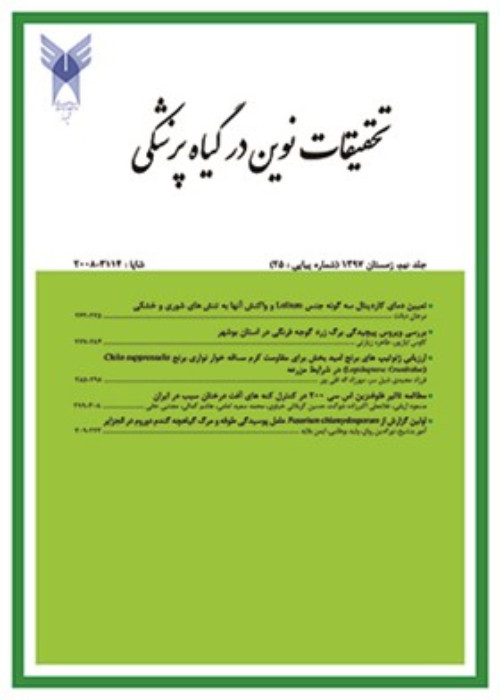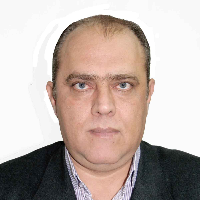Pupal hymenopterous parasitoids of Acanthiophilus helianthi (Diptera: Tephritidae) in Kohgiluyeh Safflower farms
Author(s):
Abstract:
Safflower capsule fly, Acanthiophilus helianthi Rossi (Diptera: Tephritidae) is a key pest of safflower in Kohgiloyeh (Southwest, Iran). It is mainly controlled through application of broad-spectrum insecticides, which can adversely affect safflower farms ecosystem and consequently human health. Since a first step in setting up an IPM program is to assess the biological control agents within the ecosystem, so in this research work the pupal parasitoid complex of Safflower Capsule Fly (SCF) on safflower was identified, and its natural potential in controlling the pest compared for different generations and in different locations in Kohgiloyeh during 2010-2011. Adults of the pupal parasitoids of SCF were recorded from laboratory-reared pupae, which had been collected on damaged small flower heads of the first generation and large flower heads of the second and the third generations. Rate (%) of parasitism on A. helianthi pupae was estimated as the number of parasitoids over the total count of parasitoids and flies. Ten pupal parasitoids of the host were found: Bracon hebetor, Bracon luteator, (Braconidae); Isocolus tinctorious (Cynipidae); Pronotalia carlinarum (Eulophidae); Eurytoma acroptilae (Eurytomidae); Ormyrus orientalis (Ormyridae); Colotrechnus viridis, Pteromalus sp. (Pteromalidae) and Adontomerus crassipes, Microdontomenus annulatus (Torymidae). Total parasitism varied from 1 to 16.8%, with an average of 7.7% as revealed through the present study. A comparison of the means of the pupal parasitism rate showed a significant difference at 5% level between different generations and localities. The highest rate of parasitism occurred in the first generation in all localities, as well as in years.
Safflower capsule fly, Acanthiophilus helianthi Rossi (Diptera: Tephritidae) is a key pest of safflower in Kohgiloyeh (Southwest, Iran). It is mainly controlled through application of broad-spectrum insecticides, which can adversely affect safflower farms ecosystem and consequently human health. Since a first step in setting up an IPM program is to assess the biological control agents within the ecosystem, so in this research work the pupal parasitoid complex of Safflower Capsule Fly (SCF) on safflower was identified, and its natural potential in controlling the pest compared for different generations and in different locations in Kohgiloyeh during 2010-2011. Adults of the pupal parasitoids of SCF were recorded from laboratory-reared pupae, which had been collected on damaged small flower heads of the first generation and large flower heads of the second and the third generations. Rate (%) of parasitism on A. helianthi pupae was estimated as the number of parasitoids over the total count of parasitoids and flies. Ten pupal parasitoids of the host were found: Bracon hebetor, Bracon luteator, (Braconidae); Isocolus tinctorious (Cynipidae); Pronotalia carlinarum (Eulophidae); Eurytoma acroptilae (Eurytomidae); Ormyrus orientalis (Ormyridae); Colotrechnus viridis, Pteromalus sp. (Pteromalidae) and Adontomerus crassipes, Microdontomenus annulatus (Torymidae). Total parasitism varied from 1 to 16.8%, with an average of 7.7% as revealed through the present study. A comparison of the means of the pupal parasitism rate showed a significant difference at 5% level between different generations and localities. The highest rate of parasitism occurred in the first generation in all localities, as well as in years.
Safflower capsule fly, Acanthiophilus helianthi Rossi (Diptera: Tephritidae) is a key pest of safflower in Kohgiloyeh (Southwest, Iran). It is mainly controlled through application of broad-spectrum insecticides, which can adversely affect safflower farms ecosystem and consequently human health. Since a first step in setting up an IPM program is to assess the biological control agents within the ecosystem, so in this research work the pupal parasitoid complex of Safflower Capsule Fly (SCF) on safflower was identified, and its natural potential in controlling the pest compared for different generations and in different locations in Kohgiloyeh during 2010-2011. Adults of the pupal parasitoids of SCF were recorded from laboratory-reared pupae, which had been collected on damaged small flower heads of the first generation and large flower heads of the second and the third generations. Rate (%) of parasitism on A. helianthi pupae was estimated as the number of parasitoids over the total count of parasitoids and flies. Ten pupal parasitoids of the host were found: Bracon hebetor, Bracon luteator, (Braconidae); Isocolus tinctorious (Cynipidae); Pronotalia carlinarum (Eulophidae); Eurytoma acroptilae (Eurytomidae); Ormyrus orientalis (Ormyridae); Colotrechnus viridis, Pteromalus sp. (Pteromalidae) and Adontomerus crassipes, Microdontomenus annulatus (Torymidae). Total parasitism varied from 1 to 16.8%, with an average of 7.7% as revealed through the present study. A comparison of the means of the pupal parasitism rate showed a significant difference at 5% level between different generations and localities. The highest rate of parasitism occurred in the first generation in all localities, as well as in years.
Safflower capsule fly, Acanthiophilus helianthi Rossi (Diptera: Tephritidae) is a key pest of safflower in Kohgiloyeh (Southwest, Iran). It is mainly controlled through application of broad-spectrum insecticides, which can adversely affect safflower farms ecosystem and consequently human health. Since a first step in setting up an IPM program is to assess the biological control agents within the ecosystem, so in this research work the pupal parasitoid complex of Safflower Capsule Fly (SCF) on safflower was identified, and its natural potential in controlling the pest compared for different generations and in different locations in Kohgiloyeh during 2010-2011. Adults of the pupal parasitoids of SCF were recorded from laboratory-reared pupae, which had been collected on damaged small flower heads of the first generation and large flower heads of the second and the third generations. Rate (%) of parasitism on A. helianthi pupae was estimated as the number of parasitoids over the total count of parasitoids and flies. Ten pupal parasitoids of the host were found: Bracon hebetor, Bracon luteator, (Braconidae); Isocolus tinctorious (Cynipidae); Pronotalia carlinarum (Eulophidae); Eurytoma acroptilae (Eurytomidae); Ormyrus orientalis (Ormyridae); Colotrechnus viridis, Pteromalus sp. (Pteromalidae) and Adontomerus crassipes, Microdontomenus annulatus (Torymidae). Total parasitism varied from 1 to 16.8%, with an average of 7.7% as revealed through the present study. A comparison of the means of the pupal parasitism rate showed a significant difference at 5% level between different generations and localities. The highest rate of parasitism occurred in the first generation in all localities, as well as in years.
Safflower capsule fly, Acanthiophilus helianthi Rossi (Diptera: Tephritidae) is a key pest of safflower in Kohgiloyeh (Southwest, Iran). It is mainly controlled through application of broad-spectrum insecticides, which can adversely affect safflower farms ecosystem and consequently human health. Since a first step in setting up an IPM program is to assess the biological control agents within the ecosystem, so in this research work the pupal parasitoid complex of Safflower Capsule Fly (SCF) on safflower was identified, and its natural potential in controlling the pest compared for different generations and in different locations in Kohgiloyeh during 2010-2011. Adults of the pupal parasitoids of SCF were recorded from laboratory-reared pupae, which had been collected on damaged small flower heads of the first generation and large flower heads of the second and the third generations. Rate (%) of parasitism on A. helianthi pupae was estimated as the number of parasitoids over the total count of parasitoids and flies. Ten pupal parasitoids of the host were found: Bracon hebetor, Bracon luteator, (Braconidae); Isocolus tinctorious (Cynipidae); Pronotalia carlinarum (Eulophidae); Eurytoma acroptilae (Eurytomidae); Ormyrus orientalis (Ormyridae); Colotrechnus viridis, Pteromalus sp. (Pteromalidae) and Adontomerus crassipes, Microdontomenus annulatus (Torymidae). Total parasitism varied from 1 to 16.8%, with an average of 7.7% as revealed through the present study. A comparison of the means of the pupal parasitism rate showed a significant difference at 5% level between different generations and localities. The highest rate of parasitism occurred in the first generation in all localities, as well as in years.
Keywords:
Language:
Persian
Published:
Journal of Novel Researches on Plant Protection, Volume:7 Issue: 1, 2016
Pages:
47 to 57
magiran.com/p1660594
دانلود و مطالعه متن این مقاله با یکی از روشهای زیر امکان پذیر است:
اشتراک شخصی
با عضویت و پرداخت آنلاین حق اشتراک یکساله به مبلغ 1,390,000ريال میتوانید 70 عنوان مطلب دانلود کنید!
اشتراک سازمانی
به کتابخانه دانشگاه یا محل کار خود پیشنهاد کنید تا اشتراک سازمانی این پایگاه را برای دسترسی نامحدود همه کاربران به متن مطالب تهیه نمایند!
توجه!
- حق عضویت دریافتی صرف حمایت از نشریات عضو و نگهداری، تکمیل و توسعه مگیران میشود.
- پرداخت حق اشتراک و دانلود مقالات اجازه بازنشر آن در سایر رسانههای چاپی و دیجیتال را به کاربر نمیدهد.
In order to view content subscription is required
Personal subscription
Subscribe magiran.com for 70 € euros via PayPal and download 70 articles during a year.
Organization subscription
Please contact us to subscribe your university or library for unlimited access!



